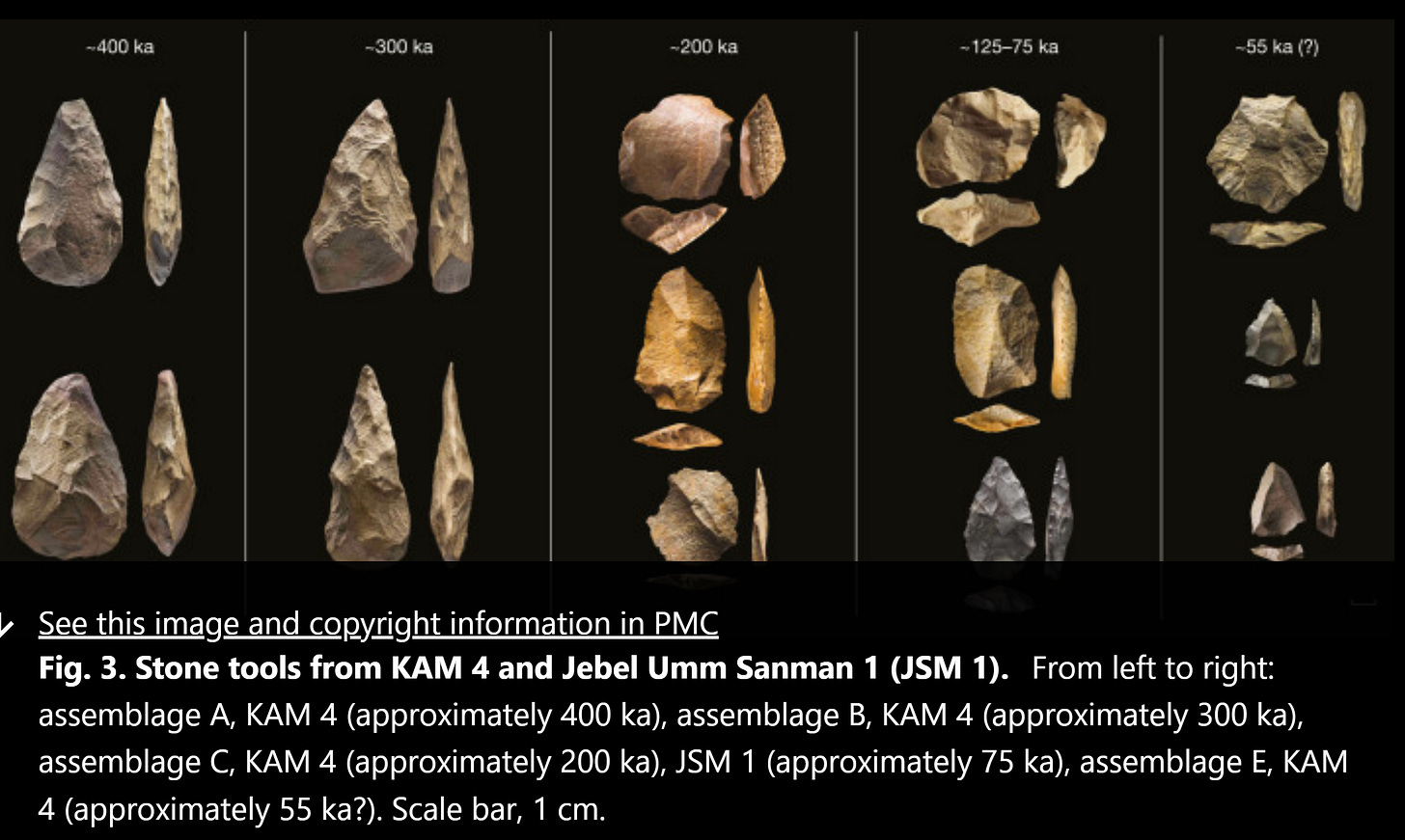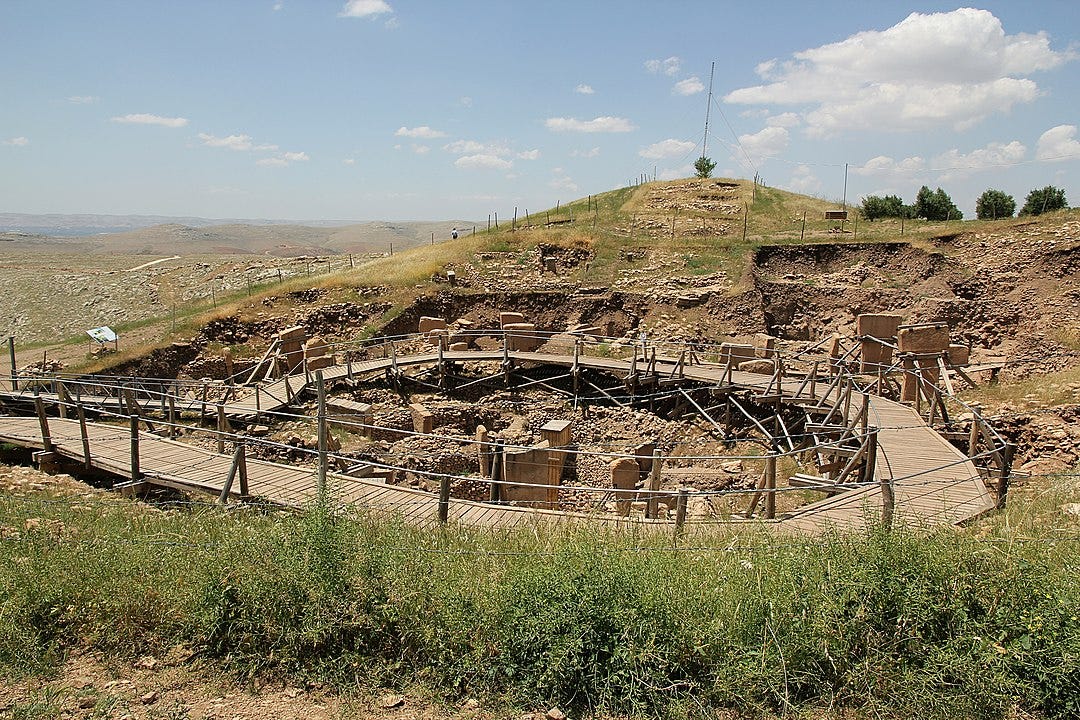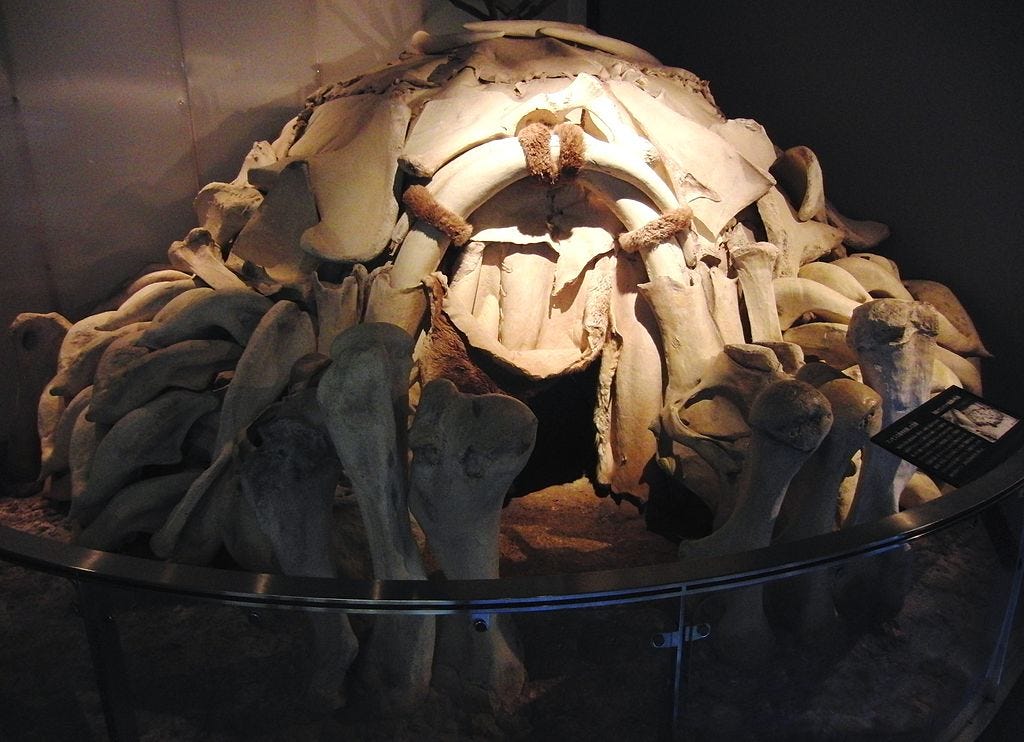Slow Read Book Club: Chapter 3, The Dawn of Everything by David Graeber and David Wengrow
What the hell were people up to in the last hundred thousand years?
Dear Reader,
I'm faltering. Yes, even I am feeling the weight of this book. I know you are, too. If you look too far ahead, it looks like an unending freeway on the horizon. Then, there are other books we have on our stacks. I have several teetering on the edge of my vision, bugging me, for work and for leisure, tormenting me endlessly day after day.
Pick me up. Choose me.
Nevertheless, I am here with you. And you compel me to show up. I have a commitment. Six months seems so long and also, too short. Thanks for keeping me on the road.
Yours in summer, Melanie
Chapter 3: Unfreezing the Ice Age
All these zeroes in the past (David Graeber and David Wengrow mark the material appearance of modern homo sapiens at around 100,000 years). Yet, here we are with too little fossils or evidence to show for it. That does not mean that early men (or other Homo species) were not busy. Indeed, what were the early humans up to?
Before we proceed…
Before we jump any further, I want to explain the human timeline. I am often confused about the immensity of the past. A visual representation can contract space and time whenever we see these dates. (Also, other very old living things, like this tree.)

Contracting human prehistory
As a reader, and even with my training, I remain confused about dates. I just can’t position myself in the timeline of the past and present of history. Let me try to simplify.
The book uses AD (Anno Domini) and BC (Before Christ) terminology familiar to the reader. I will retain this usage for simplicity. However, most academics use the term BCE (Before the Common Era) and CE (Common Era) to represent the same time period in a secular or more neutral way.1 Here’s a linear representation of the scale:

Whenever we read ‘thousands of years’ (before the present), we can calculate and plot it in the BC/AD linear scale using this formula:
[ thousands of years - AD/CE 1950 (present)] -1 = BC/BCE year
Therefore, 100,000 years ago from the present is 97,977 BC. It does not help us too much as the difference is minuscule. The reason I do this is so that you can visually plot in your head where that number is in the timeline. It is so far away from where we are now.
This dot puts us in the Holocene Epoch, right after the glaciers melted. A geologic calendar is helpful here.
Now, 3,000,000 million years ago puts us smack in the Ice Age, or more formally, the Pleistocene era. So much time, yet so little evidence.
A word of caution on fossils (or the lack of it)
I’d like to explain that archaeology is trying to understand the material world when you only have a pen and a candy wrapper as evidence. It’s not easy. When we confront the evidence, the authors caution us of the following:
Our theory of African origin remains as long as no older fossil is uncovered in other parts of the world, for now. Fossil evidence is a result of geologic opportunity (areas that allow for its preservation - dry climate, lack of human disturbance, or the exposure of rock strata during the Pleistocene period) as well as research accessibility. So far, the oldest and richest find are in dry Africa with geologic rifts that expose sea beds and strata in that time period. If there is more funding for science (and fewer human conflicts), we would have much more finds than we do now.
Absence does not necessarily mean that there was no proof of human activity in an area. Its reverse, the proliferation of fossil remains or other artefacts, does not mean that there is a ‘sudden’ or ‘prolific’ or ‘creative’ jump like in European finds. What we need to do is look at the bigger picture and the connection of these sites to others as a whole.
So this is what we will do, connect the dots to reconstruct the big picture of human prehistory that Graeber and Wengrow layout.
Now this is where the story begins…
What were people doing back then?
Given that we must rely on extant artifacts and fossil evidence, the authors reviewed finds from the Holocene and Late Pleistocene eras. They argue that this evidence is the best test for the complexity to the complicated thesis of the authors.
The solo evolutionary branching that we have in our heads may lead us to think that Homo Sapiens were alone. A multi-evolutionary perspective is supported by evidence than the single-origin myth of Mitochondrial Eve or a Garden of Eden perspective. Dr. Eleanor Scerri argues that several physical types of humans co-evolved in Africa and may have lived concurrently with each other than we are led to believe.
“The use of the term (Mitochondrial Eve) was a misinterpretation, given that the research was about the most recent common mitochondrial ancestor of all living humans … not about the first human woman ever,” says Roger Bull, a senior research assistant in the molecular biodiversity lab at the Canadian Museum of Nature
Cultural complexity or ‘cultural efflorescence’ (40,000 BC, Upper Paleolithic) is not the sole monopoly of Europe. This is one fallacy that the authors pointed out with Homo Sapiens. Though a lot of the artefacts such as the Venus figurines (at Paris’ Museum of Man) or the cave paintings in France and Spain are world famous, Homo Sapiens were also in Southwest Asia or Saudi Arabia and Africa. The spread of these toolkits stretches back up to 400,000 years ago (398,049 BC).

These stone tools assemblages were found in the Nafud Desert in present-day Saudi Arabia that shows continuous occupation by different Homo Sapiens and Neandertals populations. Ka here means kilo annum, ‘one thousand years’ before the present, i.e. -400 = 400,000 thousand years ago. Photo and copyright from the journal and its authors. The spread of toolkits across great areas and time period indicate that:
multiple populations were traveling, not in a linear one-way pattern that implies permanent settlement, but occupying and re-occupying sites seasonally
interaction and exchange between populations may be possible creating a common toolkit and skillsets to reproduce these artefacts consistently over time
People were very busy building large-scale monuments and burial sites. There are several sites that showcase complex Pleistocene cultural practices. For example, the elaborate burials at Sunghir outside of Moscow, Russia dates back to 28,190 - 26,850 BC. The finds consisted of thousands of mammoth beads, red ochre use (used for body ornaments and also found in African sites). Concurrently, the same set of practices was also found in what is now the Czech Republic - the Dolní Věstonice – Pavlov – Milovice settlement complex (28,050 - 20,050 BC). Elaborate burials and sculptural art thrived in this area.

The oldest known low-fired (500-800 Celsius) clay-fired ceramic figurine dated 29,000-25,000 BC. There are other animal figures found on the site. Courtesy of Wikipedia The most powerful evidence of Graeber and Wengrow’s thesis of complexity to the complicated is Göbekli Tepe (9000 B.C.). These are the stone temples found in the Germuş mountains, overlooking the Harran Plain in southeast Turkey. These monumental circular structures existed in a time of hunting and gathering, without intensive cultivation.

Hill site from the east in Şanlıurfa, Turkey. Photo by Klaus-Peter Simon - Own work, CC BY-SA 3.0, Another impressive mammoth bone house site was found in Yudinovo, Russia dating 18.2–17.6 kya cal BP (kilo annum calibrated years Before the Present - via stratigraphic dating)2 or roughly 16,250- 15,650 BC. Below is a reconstruction based on a find from central Ukraine of Mezhyrich, Cherkasy Oblast which sadly might be ruined due to the conflict.
Scientists led by Dr. Sablin argued that these are ‘ritual middens’ rather than dwellings as these might look like.
What does all this evidence mean?
Our ancestors were very busy and lived complicated lives. What we have is aggregated evidence of early human activity from 400,000 years ago with stone toolkits to the monuments of the last 100,000 years of the Ice Age period. The cultural efflorescence of the Pleistocene and Holocene epochs was not just found in Europe but in wider areas of the Asian to Central or Eastern European continents.
Early Hominids
However, let’s take the toolkits from early Homo species available over a large distance and areas, we can deduce:
People were seasonally traveling. They are following herds and seasonal food sources. The uncertain large distances mean people have to travel light, carrying a minimal amount of items without compromising safety, especially with the threat of attack. They could do it in two ways, bring the actual material with them (but lose the use of one/both hands) or have the skills to create tools on demand. This is why stone tools are prolific in ancient sites. With the knowledge of technique, people could identify and experiment with the same or newfound material to fashion sharp stone and other tools for hunting, cutting, slicing off skins, and cooking (if not cutting food into edible pieces).
For those following herds, it would be logical to assume that there would be other groups who are following the same animals. These human bands would be temporary competitors but also collaborators. This means social interaction and communication would be necessary to forge alliances and exchange knowledge to succeed in a hunt or timing food collection.
For people who were not moving, let’s say. They would have encountered those travelers and would have to have some form of communication and interaction with them (peaceful or not).
It is clear that there were interactions with different groups (Neandertals and other Homo species possibly) from different areas whether it is through an exchange of knowledge, transmission of information, or copying of new skill sets.
Ice Age People
The 100,000-year timeline (98,049 BC) provides much more robust evidence of the extensive human activity of Homo Sapiens.
We confirm that Homo Sapiens were indeed moving. That in itself is a huge answer.
Seasonality is the default way of life. However, people return to their old sites at certain times of the year. They were busy building, abandoning, and re-building their small-scale and large-scale monuments and/or dwellings. The limited evidence of prolonged settlements like middens (trash) and hearths (fireplaces) led to scientists saying these are rituals rather than everyday dwellings.
The separation of what is ordinary life and sacred spaces indicates a complex belief, symbolic, language, and practice systems that are able to communicate over several disparate mobile groups from different backgrounds. Seasonal dispersion is temporarily mitigated with seasonal reunions and collaborations.
Seasonal collaborations allowed monumental and large structures to be built without a state, urban cities, or agriculture! People were organising themselves and not necessarily through coercion or extraction. These monumental structures disprove a direct causality with intensive cultivation.
The elaborate burials show specialised arts and crafts skills that were learned and shared among seasonal collaborators or in contact with seasonal visitors. This is particular for the practice of painting red ochre on burial ornaments and the body.
Round-Up
Again, what does it all mean? Our ancestors provide other ways of life aside from the default capitalist forms we live in today. This is the entire point of Graeber and Wengrow. Our early ancestors were smart political animals with a very complex way of life and ritual practices that span distances. Once we accept the complex to the complicated perspective on our past, we can pose better questions that Graeber and Wengrow suggested:
How can we re-analyse evidence from our past?
What forms of social life or governance did these people have?
Can we copy it? What can we learn from it?
These questions, especially the last, were very important for both of them, but especially for Graeber, who was investigating other non-capitalist models of living. This is in essence one of the aims of the book, not just to debunk flawed reasoning, but to uncover gems we can find in how our ancestors lived.
I will integrate the political angle from this chapter with their extensive discussion in my next post. See you then!
Challenge yourself: Watch this series!
Before I end, I want you to watch a Netflix series with fresh eyes. Ancient Apocalypse is advertised as the most dangerous documentary hosted by British journalist Graham Hancock. (But honestly, I really want you to see the Göbleki Tepe in full HD! Quite astounding visually to see lesser-known monuments around the world.)
To be frank, I am unfamiliar with him or any of his previous work (not even his interview with Joe Rogan which I am now slightly interested to listen to). My ignorance means that I am willing to listen to his thesis that there are more ‘intelligent beings’ that created the magnificent marvels in the ancient world, among others. I watched six episodes and his show is highly riveting and entertaining because of the monuments I had not known before and the difficulties of classification in the wider understanding of history.3
Some questions to think about:
What would change or not change in Hancock’s arguments if we assume the complexity to the complicated framework?
What interpretation can we make if we assume that our ancestors (starting from the hunter-gatherers of the Ice Age) were advanced and complex with the capacity to build these monuments? Would re-examining the existing data result in a different series?
Based so far, on the three chapters we have read, what do you now think of our multiple Ice Age ancestors?
The AD 1950 epoch as the end of the Holocene to Anthropocene is a matter of geologic evidence rather than scientific agreement among different scientists. The Anthropocene Working Group (AWG) argued that the proliferation of nuclear testing would show increased plutonium isotopes in the rock strata. Graeber and Wengrow and other scientists point to accelerated human activity that would merit an earlier epoch. For them, it is the genocide and the loss of mass populations and cities (and thereby cultivated land) in South America with the arrival of the Spanish around 1700. The resignation of Erle Ellis from the AWG reflects the consensus decision-making and groupthink that led to the 1950 date.
The latest dating done can be found in this paper. For a simple yet full explanation of how to understand dates and dating techniques, the Crow Canyon Archaeological Center provides a helpful primer.
Andre Costopoulos, Vice Provost at McGill University, writes to fellow archaeologists about how to approach when confronted by ‘pseudo archaeology’ ideas and also what Hancock’s Netflix series brings. Personally, ‘intelligent beings’ need not be some foreign alien, if we assume past peoples were as equally intelligent as we are now, then it explains the presence of these monuments. We are just not smart enough to understand them.







I really think that scientists should engage with him and you might be right that it would be more productive if he tried to publish in an academic journal. He seems to have the comparative breadth but I believe his incredible conclusion won't hold up to limited data. Plus, you are right, the conspiracy sells books! If only there's an equivalent book contradicting his views.
I just finished the Netflix series. I found it interesting and compelling but I also think we need to be cautious when it comes to these “documentaries.” To my knowledge there was no fact checking. Perhaps it might be better to call it an op-ed in film not backed up by a lot of evidence. It’s compelling in the sense that he’s trying to suggest a forgotten history. But without the aid of science and evidence, I’m afraid it’s just one guy’s speculation and livelihood. I worry he might be cherry picking what evidence he does shows. Contrast this with a US based science series such as Nova or any BBC documentary. One of the things he does is cast himself as an irritant to scholars. And for this reason I think Joe Rogan finds him interesting (critiques of whom you may have run across). In fact at the end it felt as if each was using the other: Rogan has a reputation of rejecting experts; Hancock can expand his readership through Rogan.
I’ll have rewatch the ep on Malta: https://timesofmalta.com/articles/view/maltese-archaeologists-push-back-netflix-show-s-temple-claims.995910
Anyhow, back to your point about complex to complex. It seems, as a layperson in this field, that anthropology tries more and more to understand and deconstruct one’s own assumptions when addressing a question. And the one essential assumption the Davids are addressing is simple to complex vs complex to complex. It makes a lot of sense to critique the former. Esp given its service to imperialism and colonization.
You also spoke of snapshots in history. Perhaps in this post or the one on Chapters 3/4. This makes me think of the dynamism of any period and how a narrow snapshot thereof can lead to erroneous generalizations. I think it was in Chas Mann’s 1491 (which Graeber and Wengrow gently critique) the notion that Americans after their first encounters with Europeans would go on to suffer a kind centuries long holocaust (please check out The English on Amazon if you have not), you could be forgiven for thinking of them as primitive, simple. I think he wrote imagine a Martian going to a Nazi death camp and concluding Jewish people had no history or culture.
Enjoying all this very much. Thank you.